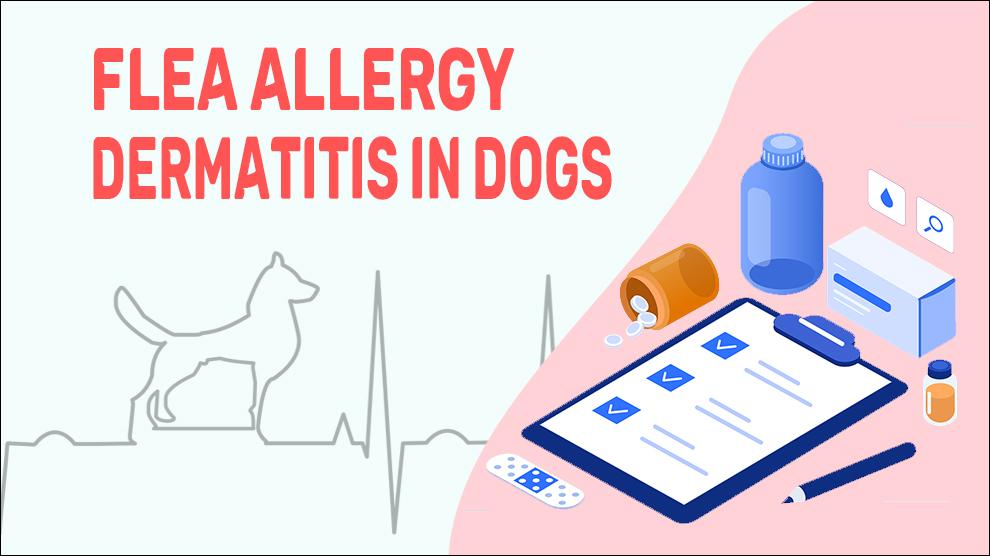What Is Flea Allergy Dermatitis In Dogs?
Flea Allergy Dermatitis (FAD), also called fleabite hypersensitivity is an allergic reaction produced in dogs in response to the injection of antigenic material (flea’s saliva) from flea bites. FAD is the leading cause of allergic reactions in dogs.
Derma in Greek means “skin” and “-itis” means inflammatory condition. The studies demonstrate that there are more than 15 immunogenic (allergenic) molecules present in the flea saliva which can cause an allergic response in the sensitized animal. When fleas bite, they instill a small amount of saliva into the skin which causes a strong itchy response in sensitive dogs.
The clinical signs can be seasonal or occur year-round depending on the geographic region. In the regions in which there are defined cold weather seasons clinical signs are most common; some dogs have problems in the warm weather months, but not always.
With the passage of time and frequent exposure, hyposensitization to flea bites may decrease the severity of the FAD without medical interference.
Symptoms Of Flea Allergy Dermatitis In Dogs
- Pruritus (Scratching, Itching, Rubbing, Licking)
- Reddening and thickening of the skin
- Papulo-crustous lesions and erythema may be present
- Greasy skin
- Patchy or inconsistent hair loss
- Secondary bacterial and yeast infections
- Self-trauma
Treatment Options For Flea Allergy Dermatitis In Dogs
Flea allergy dermatitis treatment is multifactorial.
- Allergy injections are also known as desensitization.
- Topical adulticides.: (fipronil, imidacloprid, metaflumizone, selamectin, indoxacarb).
- oral adulticides.: (nitenpyram, spinosad).
- Adulticides with insect growth regulators: pyriproxyfen and methoprene.
- Insect development inhibitors: lufenuron.
- Antihistamines - Chlortrimeton, Benadryl, Atarax, Clemastine, Claritin and Zyrtec.
- Pruritus: pruritic skin disease via antipruritic drugs.
- Antibiotics and Antifungal Medications- are required to treat secondary infections.
- Corticosteroids and Immunosuppressive Agents- Cortisone (dexamethasone, prednisone, prednisolone) and Cyclosporine (Atopica).
Home Remedies For Flea Allergy Dermatitis In Dogs
- Keep the dog clean and dry
- Use a pet friendly anti microbial wipes
- Clean food and water bowls daily
- Use ointments/Creams to ease itching & irritation
- Use Cold compresses when needed
- For the chewy or scratchy dog, Consider using an inflatable/ Elizabethan collar
Prevention Of Flea Allergy Dermatitis In Dogs
- When you find out your dog is allergic to fleas allergy, avoidance is the best method of control.
- Keep the fur/jowls/mouth clean which is usually twice a day. Use medicated wipes containing a skin disinfectant.
- Don’t forget to dry the area thoroughly after cleaning.
- Use clean paper towels (or a clean washcloth) and medicated dog shampoo (e.g. Nolvasan medicated shampoo).
- Dogs with skin folds can be cleaned daily with a clean, damp cloth, shampoo, wipes, ointment, lotion, spray, skin cleanser, etc.
- If you bathe your dog less often, you’ll have to spot clean the area daily to get rid of trapped food and moisture.
- Consult with your veterinarian dermatologist for hypoallergenic vaccinations.
Affected Dog Breeds Of Flea Allergy Dermatitis
There is no sex predisposition.
Golden Retriever, Labrador Retriever, Shar Pei, Dalmatian, Wirehaired Fox Terrier, Old English Sheepdog, Boxer, Boston Terrier, Scottish Terrier, West Highland White Terrier, Lhasa Apso, Shih Tzu
Additional Facts For Flea Allergy Dermatitis In Dogs
1. Causes:
Flea bites Sensitive dogs
2. Types:
Flea bite hypersensitivity reactions bear the trademarks of cutaneous basophil hypersensitivity reactions, immediate (type I), and delayed (type IV) hypersensitivity reactions.
Type I hypersensitivity: This is an immediate hypersensitivity reaction. It is a humoral response aggravated by re-exposure to a specific type of antigen. Immunoglobulin E binding to mast cells triggers the reaction which leads to the release of inflammatory mediators, such as histamine.
Type IV hypersensitivity: They are delayed-type hypersensitivity that is cell-mediated. This involves interactions of antigen-specific effector T cells. Copious amounts of lymphokines are activated which results in the release of pruritogenic inflammatory mediators.
Basophil hypersensitivity: This lymphocyte-mediated hypersensitivity is a transient delayed-type reaction. This sequence of reactions includes basophils in the papillary dermis and less indurated erythema.
3. Mortality:
There is no documented mortality due to this condition
4. Diagnosis:
- Complete blood count, chemistry panel
- Specialized blood tests (IgE blood tests).
- Intradermal testing (IDT)
- Serological allergy testing using ELISA
- Flea saliva antigen (FSA)
5. Prognosis:
The prognosis for flea allergy dermatitis is really good. As the existing condition is not life-threatening, no rigorous treatment is usually necessary. However, relapse will be a problem following medical treatment in affected dogs. Proper hygiene and home care are the best defenses against future recurrences.
When To See A Vet For Flea Allergy Dermatitis In Dogs?
Contact your vet right away, if you notice any of the following:
- Pruritus (Scratching, Itching, Rubbing, Licking)
- Reddening and thickening of the skin
Food Suggestions For Flea Allergy Dermatitis In Dogs
A well-balanced diet is a precautionary measure for this condition.
- Avoid providing meals that might have fats
- Omega3 fatty acids- Mackerel, Salmon, Herring, Sardines
- Lean meats, such as chicken breast, sirloin, or pork
- Leafy green vegetables, cauliflower, and broccoli
- Low fat, high protein foods- White-Fleshed Fish, Skinless, White-Meat Poultry, Beans, Peas, and Lentils
Conclusion
Flea allergy dermatitis prognosis is good with treatment. The recovery time for dermatitis is different for every dog. You’ll get a good idea of when to expect improvements depending on the treatment plan or medication schedule prescribed by your vet.

















